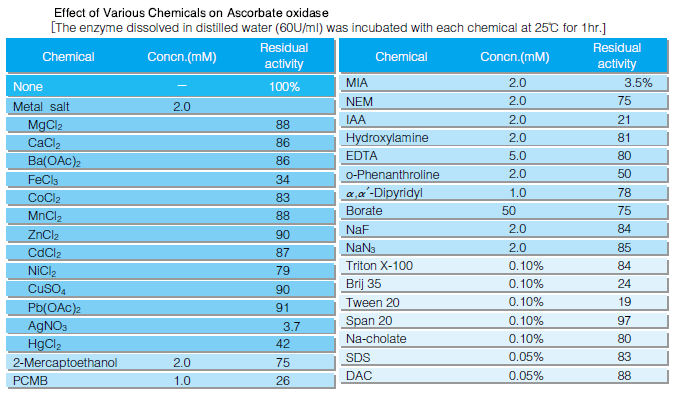| Description | Ascorbate oxidase (AO) is a cell wall-localized enzyme that uses oxygen to catalyse the oxidation of ascorbate (AA) to the unstable radical monodehydroascorbate (MDHA) which rapidly disproportionates to yield dehydroascorbate (DHA) and AA, and thus contributes to the regulation of the AA redox state.
Ascorbate oxidase is useful for enzymatic determination of ascorbic acid and for eliminating the interference of ascorbic acid in clinical analysis.

Effect of Various Chemicals on Ascorbate oxidase. |
| Chemical Properties | Appearance : Light blue amorphous powder, lyophilized
Stability : Store at -20℃ (A decrease in activity of ca.20% may occur at 5℃ within 6 months.)
Molecular weight : 132,000, 140,000
Isoelectric point : between 6.0 and 7.8 , 8.2
Michaelis constant : 2.5×10-4M (Ascorbate)
Structure : 8 copper atoms per mol of enzyme
Inhibitors : cyanide, Na2S, diethyldithiocarbamate (Na)
Optimum pH : 5.6
Optimum temperature : approx. 30℃
pH Stability : pH 7.0-10.0 (25℃, 17hr)
Thermal stability : below 40℃ (pH 8.0, 30min)
Substrate specificity : This enzyme oxidizes ascorbic acid and several ascorbic derivatives.
|
| Uses | Biochemical research. |
| Uses | Ascorbate oxidase, from Cucurbita sp., may be used to study oxidative stress and heat stress response and tolerance. Also used in ascorbic acid assays to study the heat stress response of Arabidopsis and useful for enzymatic determination of ascorbic acid and for eliminating the interference of ascorbic acid in clinical analysis. |
| Definition | An enzyme found in plant tissue that acts upon ascorbic acid in the presence of oxygen to produce dehydroascorbic acid. |
| General Description | Ascorbate oxidase is a homodimeric enzyme, which comprises 552 amino acid residues per subunit (zucchini). It corresponds to a molecular mass of 70kDa per subunit. This enzyme is mainly found in plants, fungi and eubacteria. |
| Biochem/physiol Actions | Ascorbate oxidase (AO) participates in cell growth by regulating reduction/oxidation (redox) of the apoplast. This enzyme can synthesize the oxidative molecule dehydroascorbate acid (DHA) in the apoplast. It is also involved in cell elongation and enlargement development. |